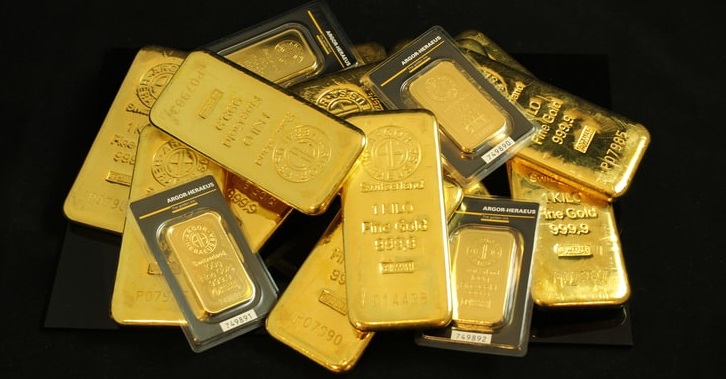Gold has been largely immune to a flurry of activity seen in other asset classes this week. Spot prices (XAUUSD) have spent most of the week consolidating around the $1800 level, hitting highs on Thursday just under $1820 and climbing from lows at the start of the week of just under $1790. The precious metal’s 21DMA, which currently resides just to the north of the $1800 level has, alongside with the $1800 on account of its psychological significance, acted as a magnet to the price action for most of the week. To the upside, key levels of resistance of note include the 50 and 200DMAs which both sit between roughly $1830 and $1840. To the downside, last month’s lows are the key area of support to watch out for at just above $1750.
As noted above, while gold has been mostly going sideways in recent days, other asset classes have seen much greater levels of volatility. Global bond yields saw a steep drop over the course of the first four days of the week (US 10-year yields dropped from the upper-1.40s% to lows under 1.25%), before seeing a strong rebound on Friday (US 10-year yields have rebounded back to 1.35%). Meanwhile, global stocks saw a sharp drop on Thursday, but have seen a decent rebound on Friday, with the S&P 500 now back to just below record levels once more. Meanwhile, in FX markets, we have seen strength in safe-haven/low yielding currencies, most notably in JPY and CHF, though USD and EUR have broadly help up well, with all four posting decent gains versus the majority of their much more risk-sensitive G10 and EM counterparts. Finally, after posting fresh post-pandemic highs at the start of the week, crude oil prices saw a sharp 8% pullback, but have since recovered to not far from flat on the week.
Before we get into discussing why gold has not seen much movement, lets quickly go over what was the main driver of this week’s choppy risk off/risk on price action; no one particular fundamental catalyst can be pinned as definitively behind this week’s volatility, but analysts have cited 1) softening PMI surveys in both the US and China, as well as indications that Chinese authorities are concerned about growth (hence the PBoC’s 50bps cut to the RRR), which seems to have hurt global growth expectations, 2) what seems to be a growing consensus that the current spike being seen in inflation across much of the globe is set to be transitory, 3) heightened uncertainty about OPEC+ policy given the ongoing rift between the UAE and Russia/the Saudis which has triggered volatility in oil prices and 4) concerns about the spread of the delta Covid-19 variant.
The combination of 1) and 2) (pretty much expectations for lower growth and inflation going forward) has been reflected in bond markets; lower long-term US yields and lower break-even inflation expectations (US 10-year break-evens have fallen from the mid-2.30s% to the mid-2.20s%). As a result of nominal US yields and inflation expectations moving lower in tandem, real US yields are actually not too much changed on the week; 10-year TIPS yields (this is the nominal 10-year bond minus 10-year break-even inflation expectations) are currently just under -0.9% not much lower than where they started the week at just above -0.9%. Remember that real yields are a key driver of gold prices given the precious metal’s strong negative correlation to them.
Elsewhere, another key driver of gold prices, the US dollar, is not much changed on the week overall. Yes, the dollar does look set to post healthy weekly gains against risk-sensitive currencies such as AUD, NZD, CAD and many in the EM space, but as far as the dollar’s overall strength is concerned, these gains are being offset by weakness in the US dollar versus the likes of JPY and CHF. As noted above, these two currencies faired the best, with FX market commentators talking about how the unwind of pro-risk carry trades (this is where you borrow in a low yielding safe-haven currency, like JPY or CHF, and lend that money in a higher interest rate currency like EM or even, yes, the US dollar). As a result of the dollar’s mixed performance versus its major peers on the week, the dollar index (DXY) is flat on the week at just under the 92.20 mark. As noted, the dollar is a key driver of gold and the fact that it was flat on the week means feeds into low volatility in the precious metal.
The bets this week on lower economic growth and inflation ahead, the main two factors driving markets this week, have thus had a net neutral impact on gold thus far. But slower growth and inflation ahead mean that the world’s major central banks ought to remain suitably dovish. We have already seen the PBoC cutting rates this week as Chinese authorities fret about the slowing credit impulse in China (and how this is likely to result in slower growth down the line). Meanwhile, a slower post-pandemic growth profile in the US ought to mean that, while we might see the start of a rate hiking cycle in late-2022/2023, the terminal rate (i.e. the rate at which they stop hiking) ought to be fairly low; 30-year yields, which currently sit just under 2.0%, suggest that financial markets expect both the Fed’s interest rate and inflation are set to average about 2.0% over the next 30 years – this is very low by historical standards.
All of the above suggests a positive long-term outlook for gold; the ongoing need for accommodative central banks, which gold loves as it signifies currency debasement and outperformance in hard-assets like gold and property and yes, maybe, crypto-currencies, ought to keep bond yields, both nominal and real, reasonably close to historic lows. This ought also to be positive for gold, given that lower bond yields make non-yielding gold a more attractive investment. That suggests that the bottom is unlikely to crater from beneath gold prices. A return to 2015-2019 levels in the $1100s-$1300s seems unlikely. Obviously if growth and inflation expectations were to sharply rise and bond yields head back to historically “normal” levels, this would be catastrophic for gold. But such a change in global economic conditions is not going to catch traders by surprise and would be a long-term play if anything.
So the outlook for bond yields seems likely to offer gold support in the long-term, what about the US dollar? This is more of a wild card. While bonds have an actual price that is based purely on economic fundamentals, currencies by nature do not have a price, they are only relative to one another. The main drivers of the US dollar going ahead will be divergences in expectations about economic growth, inflation, central bank policy and also changes in risk appetite (seeing as the dollar is also seen as a safe haven asset). At the moment, it looks as though US economic growth is going to be stronger and inflation persistently higher in the US than in Europe and Japan. Meanwhile, China seems to be losing momentum. Thus, markets expect that the Fed will be tightening monetary policy well ahead of the likes of the ECB and BoJ, which many expect will underpin medium/long-term strength in USD versus EUR and JPY. Meanwhile, as the Fed brings interest rates back towards where rates are in China and especially if this is helped by a new rate cutting cycle in the world’s second largest economy, this could spell bad news for the value of CNY versus the USD. Thus, its seems that the outlook for the dollar in the medium/long-term is constructive, which will not be a good thing for gold.
The above discussion pertains to what are very much long-term plays. In the short-term, expect gold to be driven by a combination of changes in the DXY and changes to US real yields. The expected Fed QE tapering announcement is still some way off according to the most recent FOMC minutes (most expect this announcement to come towards the end of the year) and as markets fall further into sleepy summer trading conditions, we may see volatility in the precious metal over the coming weeks die off a little.




